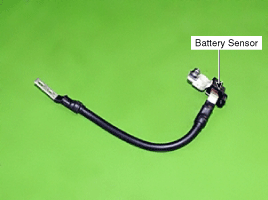Hyundai Genesis: Charging System / Battery Sensor Description and Operation
Hyundai Genesis (DH) 2013-2016 Service Manual / Engine Electrical System / Charging System / Battery Sensor Description and Operation
| Description |
Vehicles have many control units that need large amounts of
electricity. These units control their own system based on information
from diverse sensors. It is important to maintain a stable power supply
as these sensors give a variety of information. Battery sensor is
mounted on battery (-) terminal. It transmits battery voltage, current,
temperature information to ECM. ECM controls generating voltage by duty
cycle based on these signals.

When battery sensor signal fault occurs, check whether the
parasitic draw is not abnormal (Refer to vehicle parasitic current
inspection) |
It takes a few hours for a new battery sensor to detect the battery state correctly.
Perform the following process after replacing the battery sensor.
|
For the vehicle equipped with a battery sensor, be careful
not to damage the battery sensor when the battery is replaced or
recharged.
|
 Battery Troubleshooting
Battery Troubleshooting
Troubleshooting
...
 Battery Sensor Repair procedures
Battery Sensor Repair procedures
Removal
1.
Disconnect the battery negative (-) cable.
2.
Disconnect the battery sensor connector (A).
3.
Remove the battery negative (-) cable after removing the bolts (B).
Installation
...
Other information:
Hyundai Genesis (DH) 2013-2016 Service Manual: Components and Components Location
Components 1. Rear window glass ...
Hyundai Genesis (DH) 2013-2016 Service Manual: CVVT Assembly Description and Operation
Description Continuous Variable Valve Timing (CVVT) system advances or retards the valve timing of the intake and exhaust valve in accordance with the ECM control signal which is calculated by the engine speed and load. By controlling CVVT, the valve over-lap or under-lap occurs, which m ...
© 2013-2025 www.hgenesisdh.com


